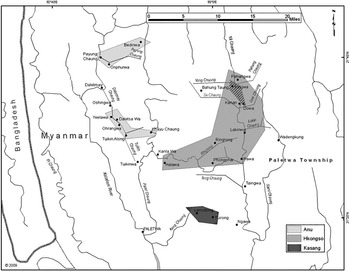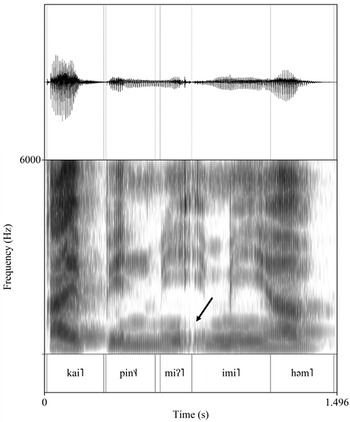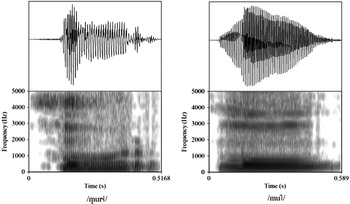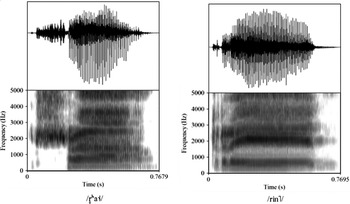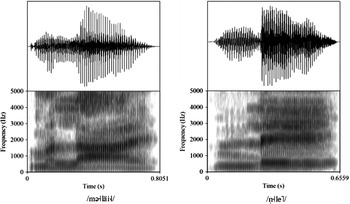Khongso /kʰɔŊ˦so˧/ is an SVO Tibeto-Burman language spoken by between two and three thousand speakers in Paletwa Township, Southern Chin State, Myanmar (Dryer Reference Dryer2008, Wright Reference Wright2009). The speakers live in 17 villages primarily along the Michaung River (see Figure 1).Footnote 1 Khongso is mutually intelligible with Anu, which has a population of 700 and is spoken west of the Khongso area (So-Hartmann Reference So-Hartmann1988, Wright Reference Wright2009, Lewis, Simons & Fennig Reference Lewis, Simons and Fennig2016). The ISO code for Khongso and Anu is anl and the glottolog code is anuu1241.
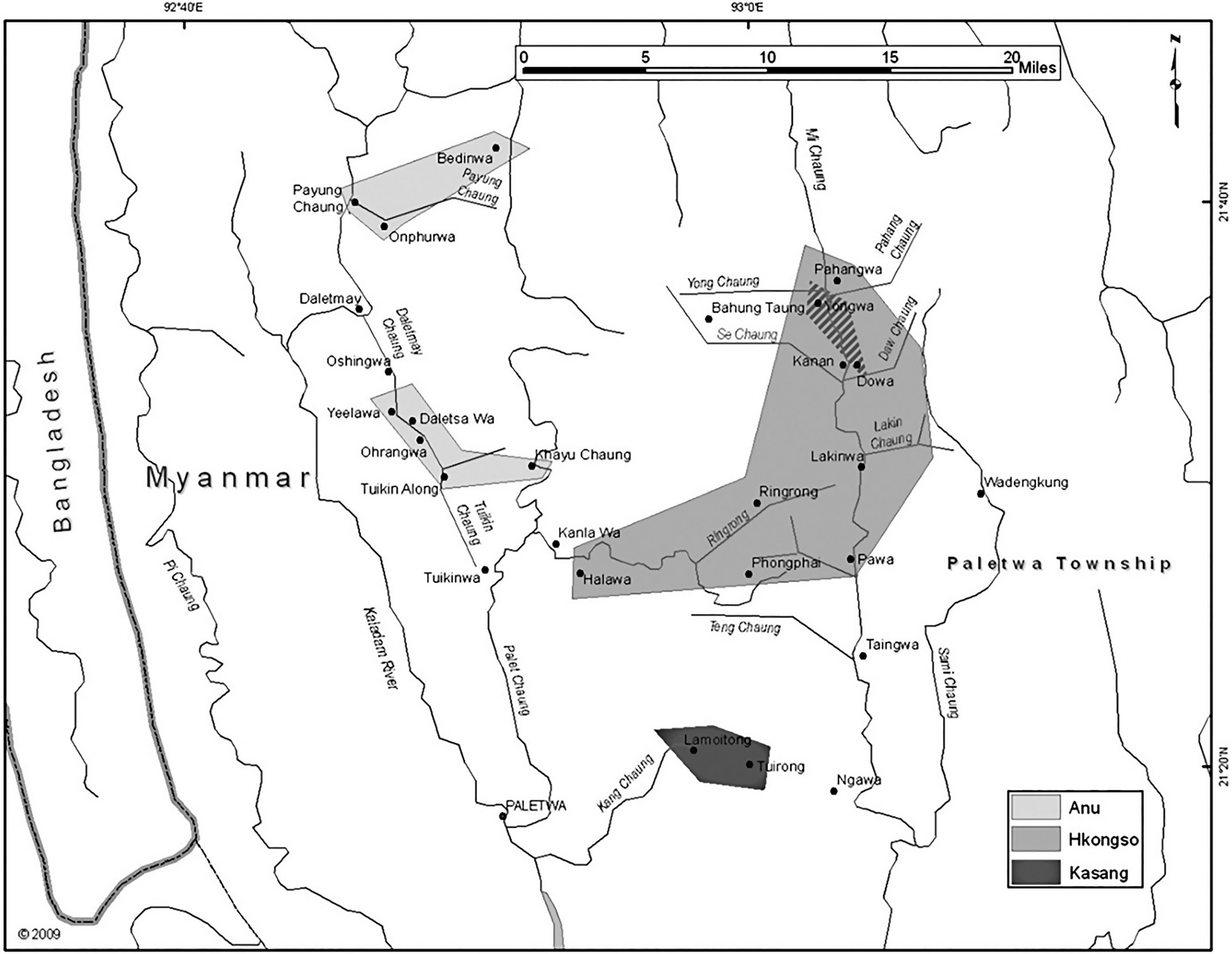
Figure 1 Distribution of the Khongso, Anu, and Kasang languages.
Although mutually intelligible, Khongso and Anu were previously listed as separate languages by the Burmese government (Burma Socialist Party 1968). Today, their cultural differences have resulted in separate sociolinguistic groupings. The Khongso and Anu language was considered a Tibeto-Burman isolate for many years, but recent evidence has led to further clarification (Peterson & Wright Reference Peterson and Wright2009, Wright Reference Wright2009). Khongso and Anu are now listed together as a separate Burmish branch with the Mru of Bangladesh, the only other SVO language in the area (Peterson Reference Peterson2006, Peterson & Wright Reference Peterson and Wright2009, Lewis et al. Reference Lewis, Simons and Fennig2016).
The Khongso, Anu, and Mru language group differs grammatically from the Chin languages around it. Khongso differs in these ways: it has no inflectional morphology, very little derivational morphology, no classifier system, no verb stem alternation, and is SVO (see Wright Reference Wright2009 for further information on morphosyntactic characteristics). The syllable structure is primarily monosyllabic with (C)(C)V(C) (e.g. /kläŊ˧/ ‘body’) or sesquisyllabic with a minor syllable followed by a major syllable (e.g. /kəวvəŊ![]() / ‘to fall’). Minor syllables are characterized by reduced onset inventories, a nucleus limited to /ə/, and a tone limited to a mid tone. Alternatively, they may be syllabic nasals. Major syllables exhibit a full range of syllable structures and tones (see section ‘Word structure’). There are five contrastive tones (see section ‘Tone’).
/ ‘to fall’). Minor syllables are characterized by reduced onset inventories, a nucleus limited to /ə/, and a tone limited to a mid tone. Alternatively, they may be syllabic nasals. Major syllables exhibit a full range of syllable structures and tones (see section ‘Word structure’). There are five contrastive tones (see section ‘Tone’).
Prior linguistic description of Khongso is limited to Wright (Reference Wright2009). For that study, linguistic information was collected from speakers living in or traveling to Yangon from the Khongso area. Khongso research assistants also collected recordings in main Khongso villages forming my Khongso data corpus. This corpus was supplemented by more recent data collection in 2015 which occurred similarly. From this corpus, recorded wordlists from a single Khongso speaker were compiled for the present analysis and illustrations. The speaker is male in his forties. He lived in the Khongso village, Yongwa, until his late 20s when he moved to Yangon. His parents were both born in Kanan and spoke Khongso to him as a child. This speaker also recorded ‘The North Wind and the Sun’ for this article.
Consonants
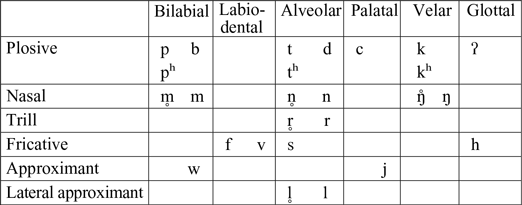
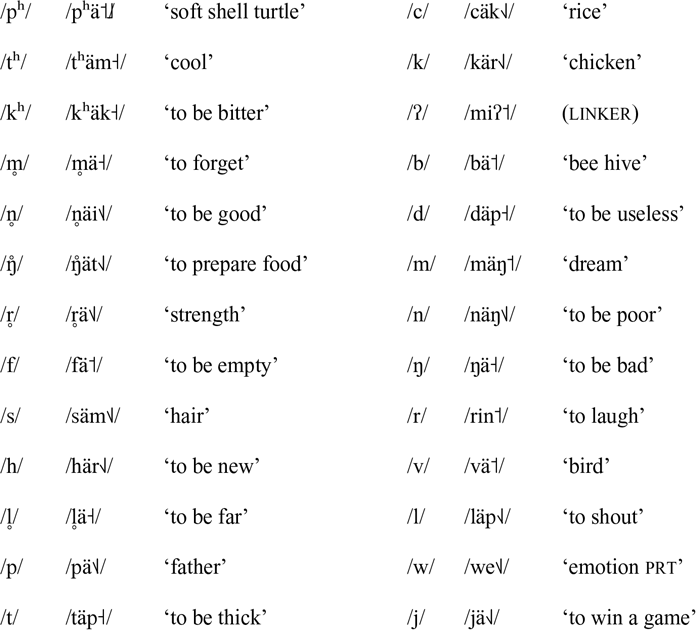
Plosives
Plosives in Khongso occur at five places of articulation: bilabial, alveolar, palatal, velar, and glottal. In the bilabial and alveolar regions there is a three-way plosive contrast: voiceless /p/ and /t/, voiceless aspirated /pʰ/ and /tʰ/, and voiced /b/ and /d/. Alveolar plosives are articulated in the dental region by some speakers. Velar plosives are voiceless /k/ and voiceless aspirated /kʰ/. A voiced velar plosive does not occur. Plosives that occur word-finally are not released or voiced.
The voice onset time (VOT) for plosives differs by place, voicing, and aspiration. Table 1 contains measurements from the Khongso speaker’s plosive onsets over 282 syllables: /b/ (n = 20), /d/ (n = 11), /k/ (n = 109), /kʰ/ (n = 16), /p/ (n = 53), /pʰ/ (n = 8), /t/ (n = 50), /tʰ/ (n = 15). These VOT measurements are relative to the release burst. Voice onset occurring before release, as in voiced plosives, are therefore negative and after release, as in voiceless plosives, are positive.
Table 1 Voice Onset Time of plosives.

Unasp. = unaspirated; Asp. = aspirated
Figure 2 shows VOT measurements accumulated across three places of articulation. The mean VOT for 212 unaspirated tokens is 0.024 seconds, for 39 aspirated tokens is 0.096 seconds, and for 31 voiced plosive tokens is −0.087 seconds. A linear regression was conducted to compare the effect of plosive type on VOT over the 282 tokens. Results indicated a significant effect, F(7,274) = 187.6, p < .001.Footnote 2 Specifically, voiceless aspirated plosives had a significantly longer VOT than voiceless unaspirated plosives (F(1,280) = 768.46, p < .001). Voiced plosives also had significantly longer VOT than voiceless unaspirated plosives (F(1,280) = 508.66, p < .001). These results are common among languages with three-way plosive contrasts (Lisker & Abramson Reference Lisker and Abramson1964, Henton, Ladefoged & Maddieson Reference Henton, Ladefoged and Maddieson1992).
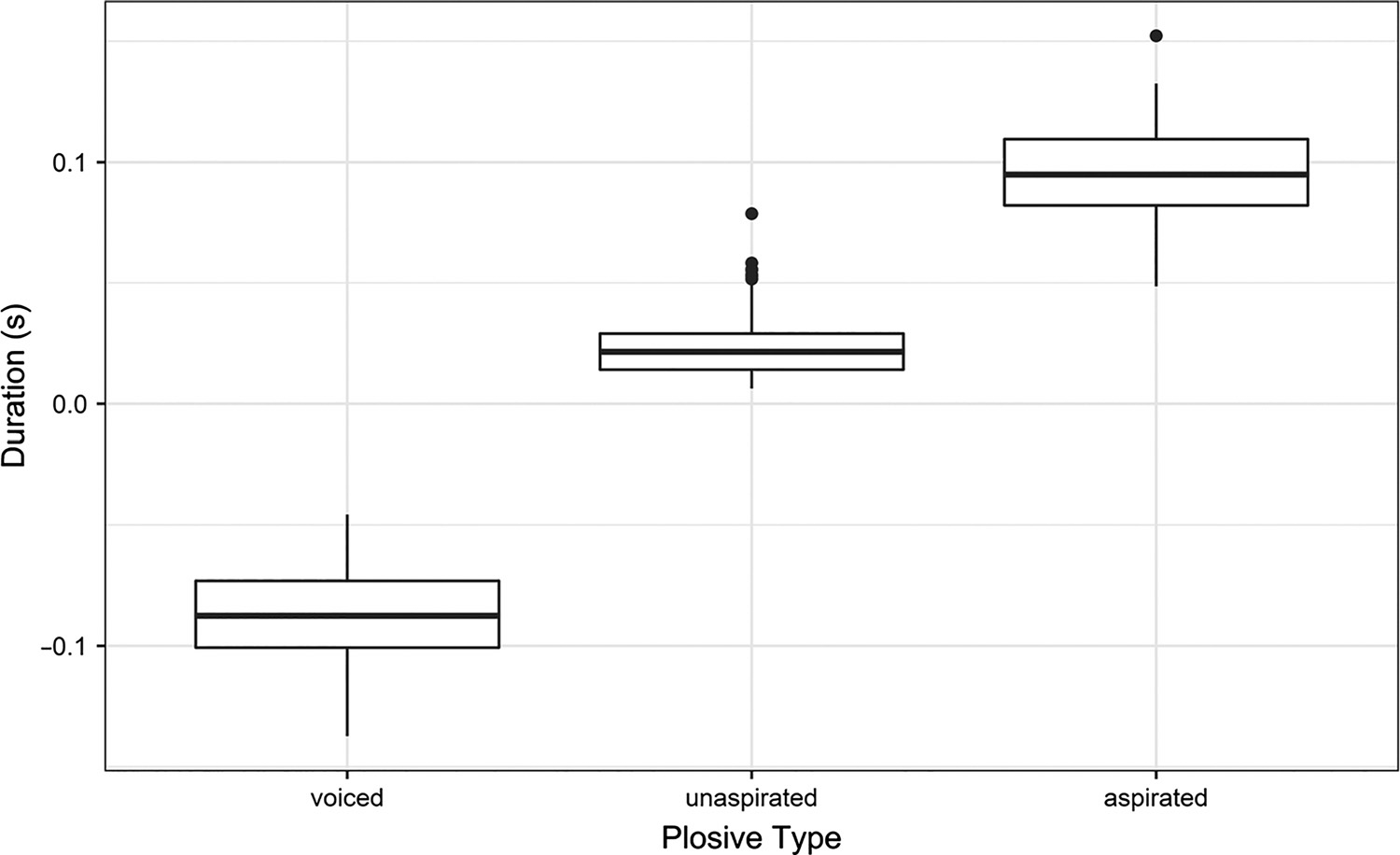
Figure 2 Voice onset time duration in seconds by plosive type.
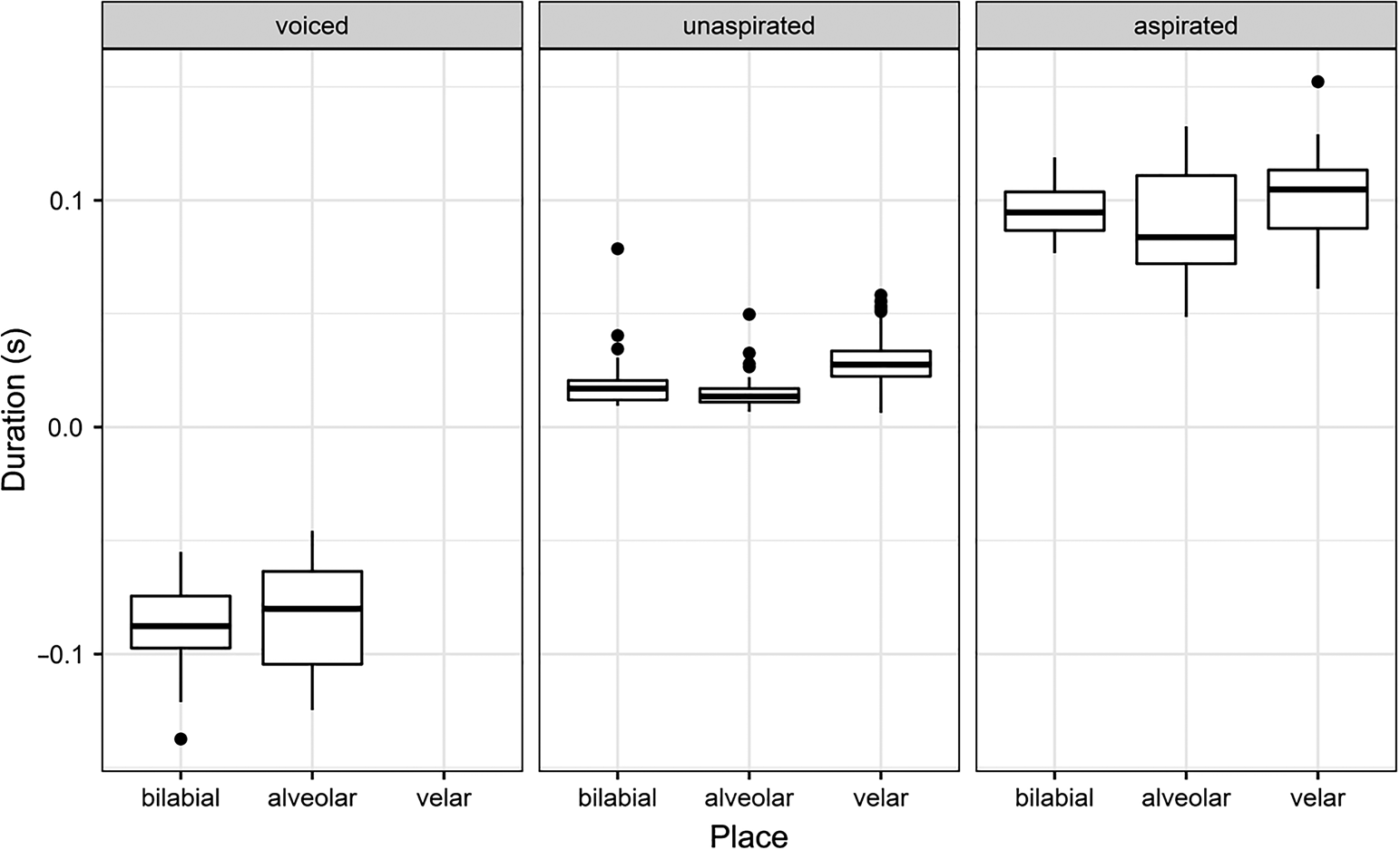
Figure 3 Voice onset time duration in seconds by place across plosive type.
Figure 3 shows the VOT measurements for each place of articulation separated by plosive type. A linear regression indicated that place of articulation was a significant factor for voiceless unaspirated plosives (F(2,209) = 43.61, p < .001), with voiceless unaspirated velar plosives having significantly longer VOTs. Place was not significant for voiceless aspirated plosives (F(2,36) = 1.47, p = .24) or voiced plosives (F(1,29) = 0.22, p = .65). These results are not unexpected. Longer VOT for voiceless unaspirated velar plosives is common (Lisker & Abramson Reference Lisker and Abramson1964, Henton et al. Reference Henton, Ladefoged and Maddieson1992). Also, voiced velar plosives are often absent from plosive inventories (Ohala Reference Ohala and MacNeilage1983).
The realization of the palatal /c/ is variable. The speaker in this study produces [c]. Other speakers in my corpus produce it as [t͡s] or [t͡ʃj]. Some Myanmar loan words, such as /tʃäunว/ ‘school’, contain the affricate [t͡ʃ]. For these words some Khongso speakers produce [t͡ʃ] and some produce [c].
The glottal stop occurs word-finally. Figure 4 illustrates a glottal stop occurring on the linker /miʔฦ/.Footnote 3 This contrasts with the following word /iฦ-miฦ/ ‘1pl-people (person)’, where there is no break in voicing going into the next word.
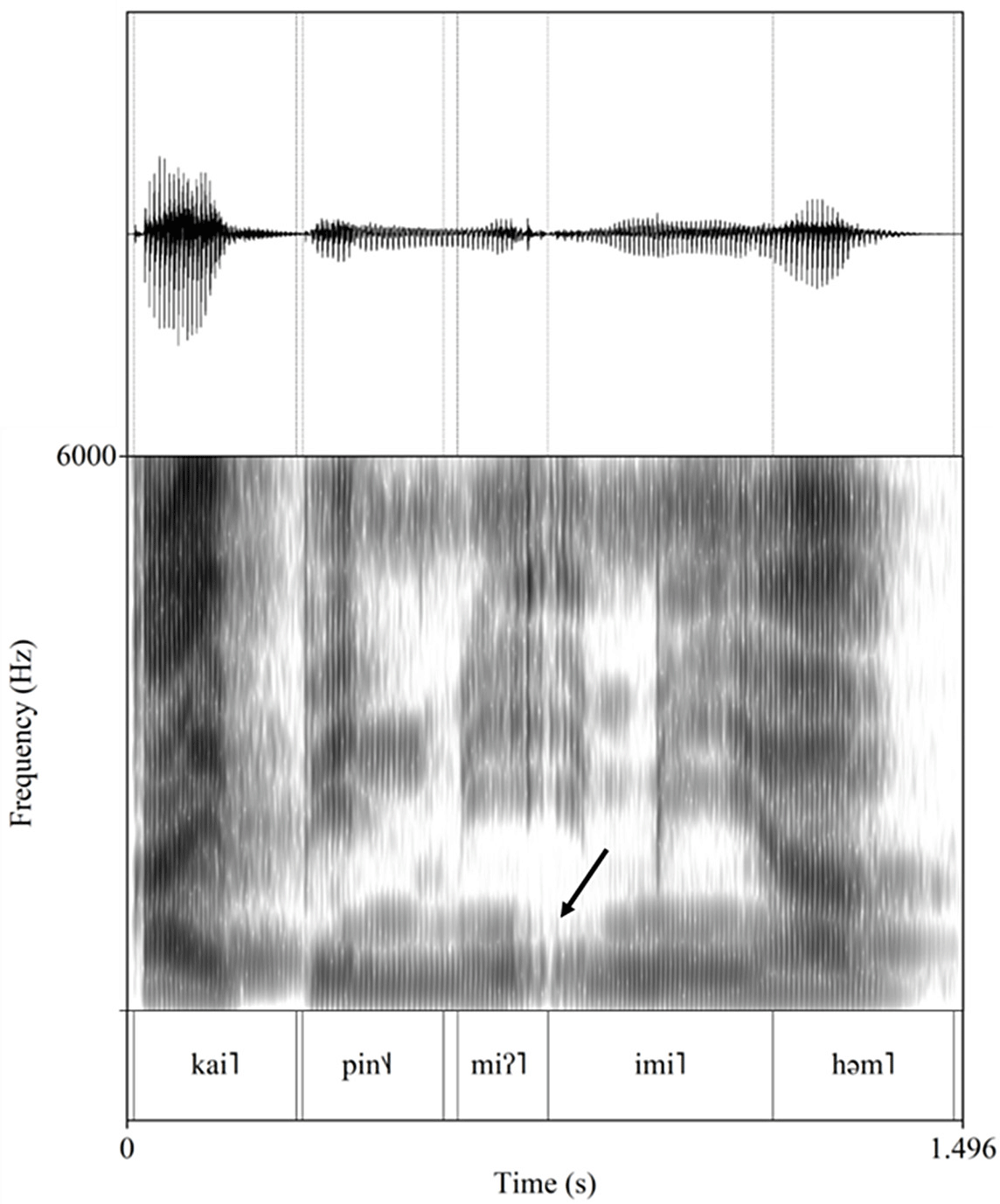
Figure 4 Final glottal stop.
Nasals
Nasals in Khongso occur in three places of articulation and are voiced and voiceless: voiced bilabial /m/, voiceless bilabial /m̥/, voiced alveolar /n/, voiceless alveolar /n̥/, voiced velar /Ŋ/, and voiceless velar /Ŋ̊/. Voiced nasals occur in the onset, coda, and in initial syllabic nasals in disyllabic words. Voiceless nasals only occur in the onset.
Figure 5 contrasts /m̥/ and /m/ in the words /m̥urว/ ‘to wipe the face’ and /muฦ/ ‘dark’. In /m̥urว/ the nasal friction from /m̥/ occurs between 4000 Hz and 5000 Hz for approximately 0.1 second before voicing onset.
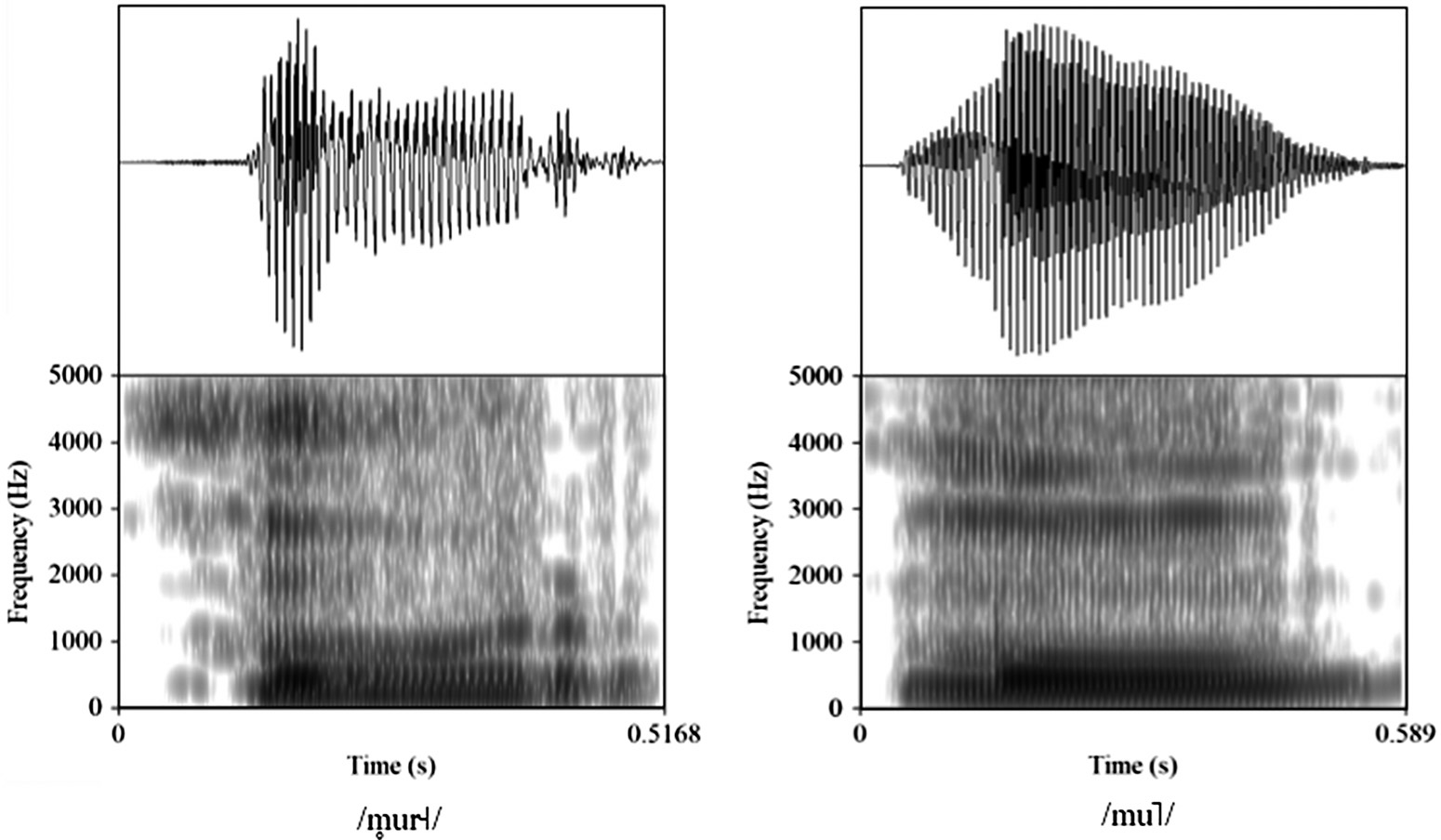
Figure 5 Voiceless and voiced bilabial nasals.
Trills
Trills in Khongso occur in the alveolar region and are voiced /r/ and voiceless /r̥/. The voiced trill occurs in the onset, coda, and as the second consonant in clusters within syllable onsets. The voiced trill /r/ is variable and may be realized as [ɾ] or [ɹ]. Figure 6 contrasts /r/ and /r̥/ in the words /r̥ä˦/ ‘strength’ and /rinฦ/ ‘to laugh’. In /r̥ä˧/ the airflow is directed over the vibrating apical articulator for approximately 0.2 seconds before voicing onset. This contrasts with /rinฦ/ in Figure 6, where voicing occurs with the trill.
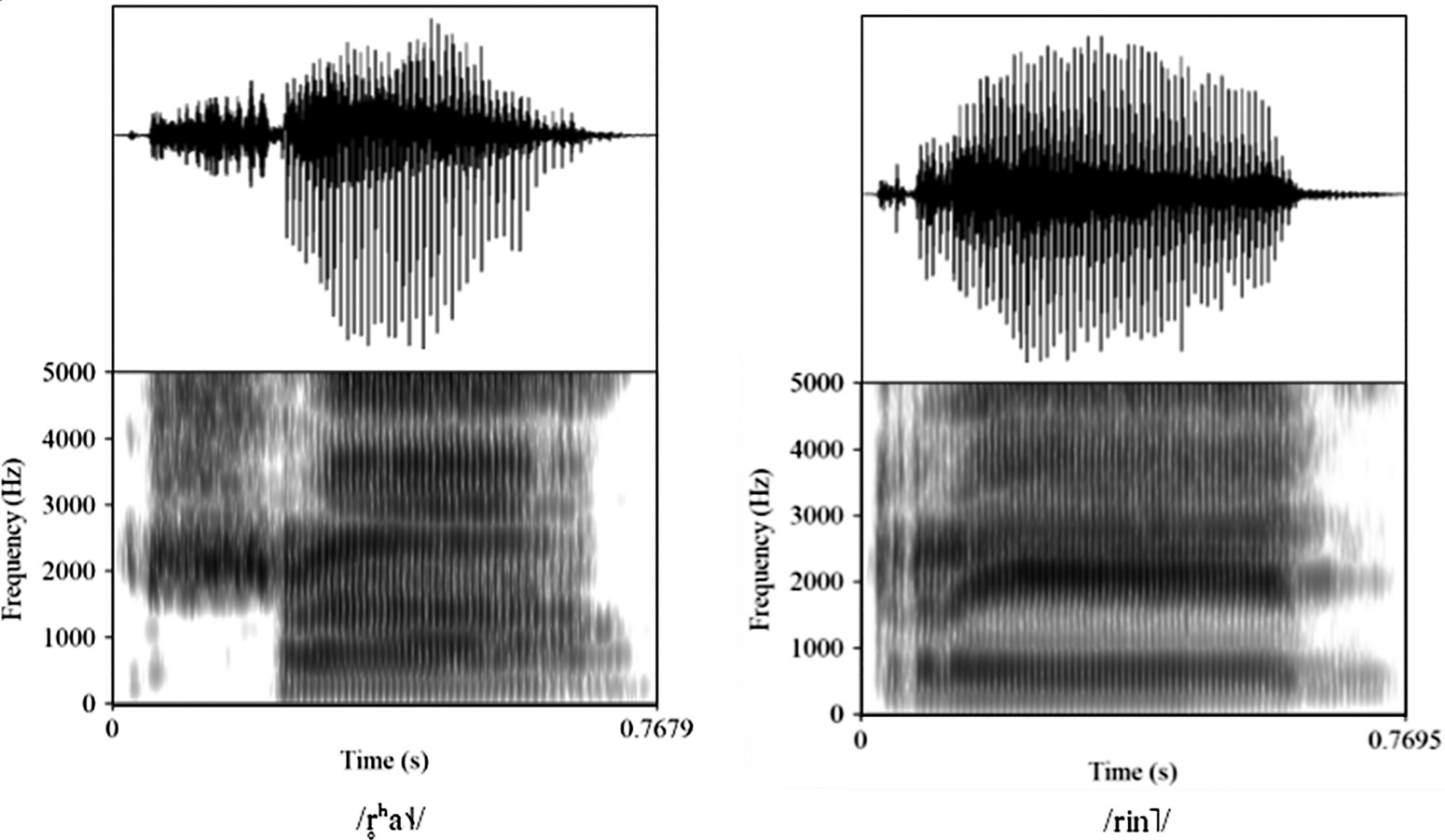
Figure 6 Voiceless and voiced alveolar trills.
Fricatives
Fricatives in Khongso occur in three places of articulation: labio-dental /f/ and /v/, alveolar /s/, and glottal /h/. Examples include /fäฦ/ ‘to be empty’, /väฦ/ ‘bird’, /säm˦/ ‘hair’, and /här˧/ ‘to be new’. The voiced fricative [z] occurs in English loan words, but does not occur in words with Khongso origins.
Laterals and approximants
Approximants in Khongso occur in two places of articulation: bilabial /w/ and palatal /j/. There are two alveolar lateral approximantsː voiced /l/ and voiceless /l̥/. All approximants and laterals occur syllable-initially and all but /l̥/ may occur as the second consonant in clusters within syllable onsets. None occur in syllable codas.
Vowels
Monophthongs
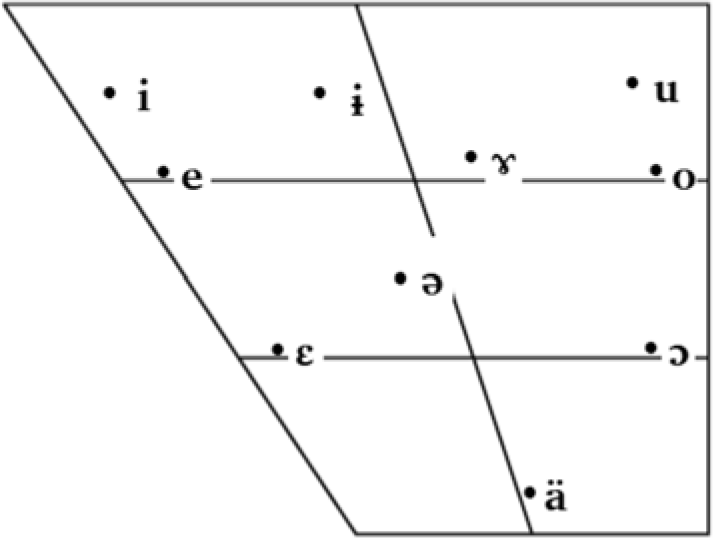
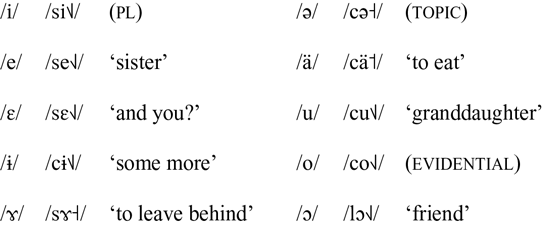
Khongso has 10 monophthongs, /i e ɛ ɨ ɤ ə u o ɔ ä/. All monophthongs occur in open syllables and in closed syllables. Figure 7 shows the F1 and F2 values of each monophthong, converted to Bark following Traunmüller’s formula (Traunmüller Reference Traunmüller1997). Individual data points show the extent of variability of each vowel space. The large filled circles represent the mean of each vowel. The ellipses are set at a .67 confidence interval, only to aid visualization of the vowel space. Measurements of data points were taken from the midpoint of each vowel. As previously discussed, samples came from wordlists produced by a single Khongso speaker. There were a total of 610 samples with the following numbers for each monophthong: /i/ (n = 76), /e/ (n = 30), /ɛ/ (n = 19), /ɨ/ (n = 42), /ɤ/ (n = 25), /ə/ (n = 93), /u/ (n = 107), /o/ (n = 18), /ɔ/ (n = 48), /ä/ (n = 152).
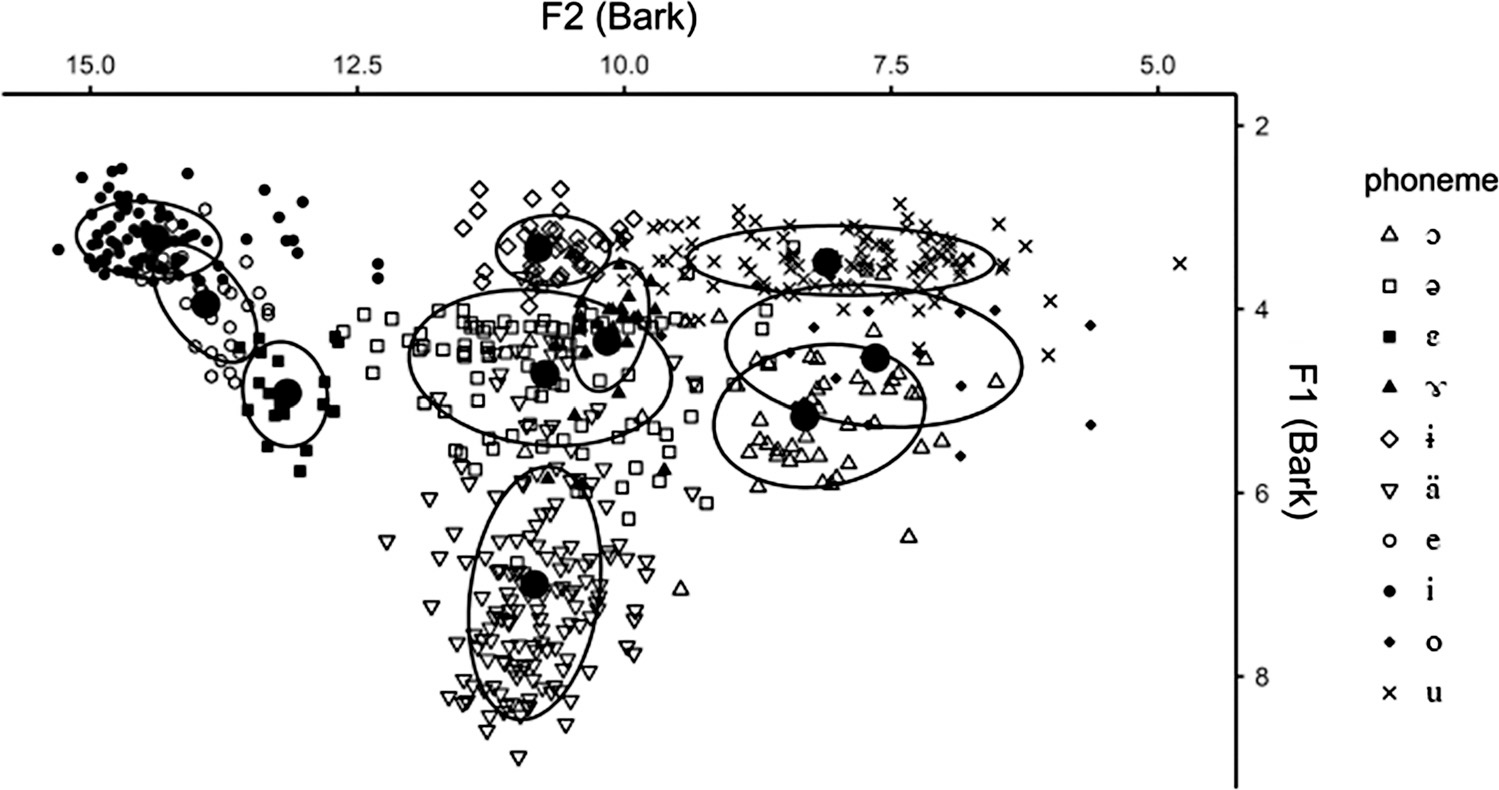
Figure 7 F1 and F2 values of Khongso monophthongs.
The monophthong /i/ is a close front unrounded vowel. In syllables with alveolar nasal codas, such as [rɪnฦ] ‘to laugh’, /i/ is realized as /ɪ/. The other two front vowels, /e/ and /ɛ/, are both unrounded. Both occur in closed and open syllables. However, /ɛ/ primarily occurs in syllables with stop codas, as in /pʰlɛk˧/ ‘to splatter’. When /ɛ/ occurs word-finally, the word is typically a sentence-final particle. The central vowels /ɨ ɤ ə/ are unrounded and all occur in open and closed syllables. However, /ə/ primarily occurs in unstressed syllables. As Khongso has a sesquisyllabic word structure, these are typically the first syllable in disyllabic words. The back vowels /u o ɔ/ are the only rounded vowels. They occur contrastively in open and closed syllables. The open central unrounded vowel /ä/ also occurs in open and closed syllables.
Diphthongs
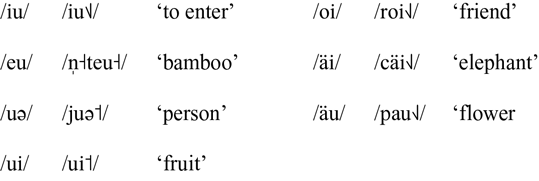
Khongso has seven diphthongs. In the present data, all diphthongs only occur in open syllables in Khongso words. However, some Myanmar loan words, such as /tʃäunว/ ‘school’, are produced with a diphthong followed by a final consonant. The possibility of diphthongs followed by a consonant coda precludes the analysis of diphthongs as monophthongs followed by glides. The monophthong + glide analysis would lead to complex consonant codas in words such as /tʃäunว/ ‘school’, and complex consonants are not found in unambiguous syllables.
Of the seven diphthongs, /ui oi äi/ glide towards a close front target, /uə/ glides to the central target /ə/, and /iu eu au/ glide to the back close target /u/.
Figure 8 shows the mean F1 and F2 values for each diphthong, converted to Bark following Traunmüller’s formula (Traunmüller Reference Traunmüller1997). Arrows in Figure 8 demonstrate the trajectories of the formant movement of each diphthong. The starting and end points of the arrows represent means measured at twenty percent and eighty percent of the duration of each diphthong. Although the F1 level of /uə/ may suggest [oə] rather than [uə], the consistent orthographic transcription as ua in the orthography together with an increase in lip rounding over that present on /o/ leads to a preference of /uə/. There were a total of 86 samples with the following numbers for each diphthong: /iu/ (n = 3), /eu/ (n = 2), /uə/ (n = 8), /ui/ (n = 27), /oi/ (n = 7), /äi/ (n = 24), /äu/ (n = 15).
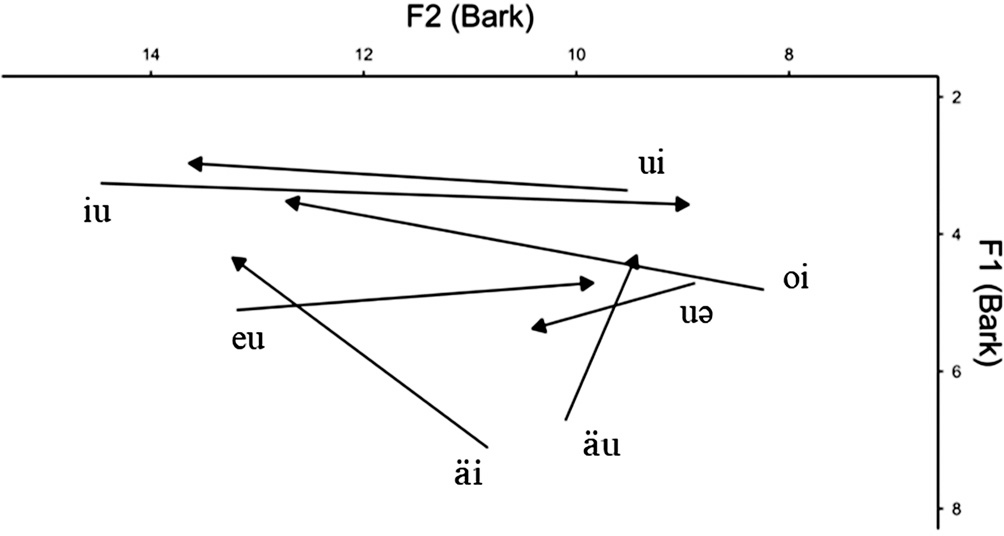
Figure 8 F1 and F2 values of Khongso diphthongs.
Table 2 Tones.
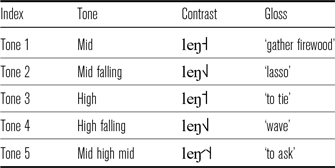
Tone
As listed in Table 2, Khongso has five contrastive lexical tones with two level and three contour tones. Figure 9 shows the tones displayed with normalized time. Pitch measurements were done in PRAAT and were taken at every five percent of the word to create normalized time. Measurements between 20 and 90 percent of the vocalic portion of the syllable were used. Measurements outside of this range were more difficult to measure consistently because of surrounding consonants or transitions to silence. These measurements come from 285 monosyllabic words selected from the word lists used for other measurements throughout the current paper: mid (n = 54), mid falling (n = 118), high (n = 41), high falling (n = 54), mid high mid (n = 17). They were taken from the single Khongso speaker.
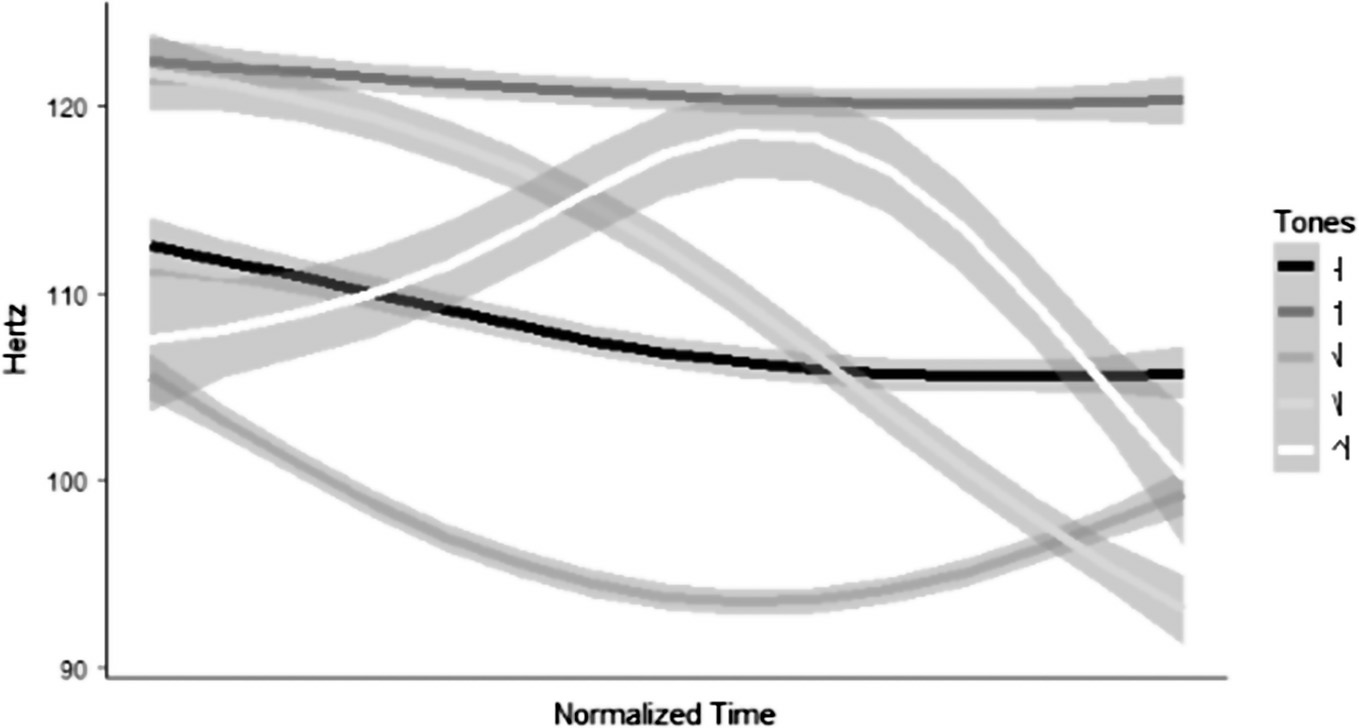
Figure 9 Lexical tones.
The F0 contour lines in Figure 9 represent the mean of those measurements with the grey areas representing ±1 standard error of the mean. The mid tone is represented by the black line, the high tone is represented by the dark gray line, the mid falling tone is represented by the gray line, the high falling tone is represented by the light gray line, and the mid high mid tone is represented by the white line. In Figure 9 the mid falling tone rises at the end. The mid falling tone varies on its ending. In word lists some speakers end with a rise while others do not. In context a final rise rarely occurs.
Duration of tones was measured using a linear regression. There was no significant variance of duration between tones (F(4,279) = 1.38, p = .24). The means and standard deviations are shown in Table 3.
Table 3 Means and standard deviations of tone duration in seconds.
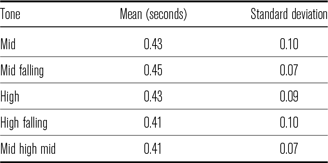
Tones are not restricted in major syllables, which are mentioned in the introduction and discussed in the following section. Each tone may occur in open or closed syllables, as illustrated in (1) and in Table 2.
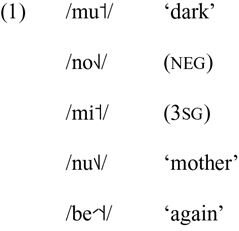
However, non-final syllables in polysyllabic words typically lose their tonal contrasts, and are realized with a level mid tone, as illustrated in the trisyllabic word in (2) and disyllabic words in (3).
![]()

Unlike tones in other Southern Chin languages, Khongso tones are resistant to change across phonetic and morphophonemic environments, maintaining similar contours in isolation and in discourse. Although tone sandhi processes are not obvious, preliminary analysis suggests that Khongso tones are not entirely immutable. Future analysis will illuminate sources of variation.
Samples of the mid falling tone in this study frequently occur with creaky voice. Covariation of non-modal phonation and F0 is common in tonal languages, particularly Tibeto-Burman languages (Bradley Reference Bradley and Bradley1982, Watkins Reference Watkins2000, Gruber Reference Gruber2011, Yu & Lam Reference Yu and Lam2014). However, phonation contrasts can occur in tonal languages independent of F0 contrasts (Silverman Reference Silverman1997). Also, non-modal phonation can simply covary with low F0 levels (Gordon & Ladefoged Reference Gordon and Ladefoged2001, Kuang Reference Kuang2017). Finally, this feature may be indicative of the population or may simply be idiosyncratic. Future work will address these considerations.
Word structure
Khongso is an isolating language with little derivational morphology and no inflectional morphology. Most words are primarily monosyllabic (e.g. /muฦ/ ‘dark’), but disyllabic (e.g. /kəวvəŊ![]() / ‘to fall’) and polysyllabic (e.g. /ləวkʰəlวklomฦ/ ‘to be happy’) words can occur. Most disyllabic words are sesquisyllabic, with a minor syllable followed by a major syllable. However, in compound words where the meaning of individual syllables can be reconstructed, as in
/ ‘to fall’) and polysyllabic (e.g. /ləวkʰəlวklomฦ/ ‘to be happy’) words can occur. Most disyllabic words are sesquisyllabic, with a minor syllable followed by a major syllable. However, in compound words where the meaning of individual syllables can be reconstructed, as in![]() ‘1pl-people (person)’, both syllables can be full.
‘1pl-people (person)’, both syllables can be full.
Rhythm
Khongso exhibits a rhythmic pattern consisting of combinations of minor and major syllables in an iambic pattern (unstressed-stressed) which is typical of languages of mainland Southeast Asia, including Mon-Khmer languages, Thai, and Burmese (Donegan & Stampe Reference Donegan, Stampe, Richardson, Marks and Chukerman1983, Wheatley Reference Wheatley and Comrie1987). Initial elements of polysyllabic constructions tend to be shorter due to this rhythmic pattern.
Sesquisyllable
Disyllabic words in Khongso meet Bennett’s (Reference Bennett1995) and Butler’s (Reference Butler2014) sesquisyllable criteria, meaning that they contain a reduced ‘minor’ syllable followed by a full ‘major’ syllable. Other polysyllabic words, such as trisyllabic words, are similar in that they contain reduced syllables followed by a major ultimate syllable. Major syllables in Khongso exhibit a full range of syllable structures and tones (see sections ‘Major syllable structure’ and ‘Tone’). Minor syllables, on the other hand, are reduced. They contain a single initial consonant (CI), allowing a reduced consonant inventory (see Table 4), followed by /ə/, and only a level mid tone. Syllabic nasals (N̩) can also occur as a minor syllable, and so the minor syllable is diagrammed as CI![]() or N̩. Syllabic nasals precede major syllables and they do not significantly differ in duration from CI
or N̩. Syllabic nasals precede major syllables and they do not significantly differ in duration from CI![]() syllables. A linear regression including major, CI
syllables. A linear regression including major, CI![]() , and N̩ syllables, contrast coded to compare CI
, and N̩ syllables, contrast coded to compare CI![]() and N̩ syllables, shows no significant difference between the duration of CI
and N̩ syllables, shows no significant difference between the duration of CI![]() syllables (mean = 0.10, sd = 0.04, n = 70) and N̩ syllables (0.11, 0.03, n = 16), F(1,573) = 0.09, p = .76.
syllables (mean = 0.10, sd = 0.04, n = 70) and N̩ syllables (0.11, 0.03, n = 16), F(1,573) = 0.09, p = .76.
Table 4 Sesquisyllabic word structure.

The major syllable can contain a complex onset with an initial consonant (CI) followed by a second consonant (C2). The nucleus can be a monophthong or a diphthong, and the coda can be a single final consonant (CF). The major syllable is diagrammed as (CI)(C2)V(V)(CF) (see section ‘Major syllable structure’). The allowable sesquisyllabic word structure is shown in Table 4.
Figure 10 provides a visual representation of the similar duration between CI![]() and N̩ minor syllables in the words /məวläi˧/ ‘rich’ and /n̩วleฦ/ ‘path’. Both are followed by major syllables with significantly longer durations.
and N̩ minor syllables in the words /məวläi˧/ ‘rich’ and /n̩วleฦ/ ‘path’. Both are followed by major syllables with significantly longer durations.
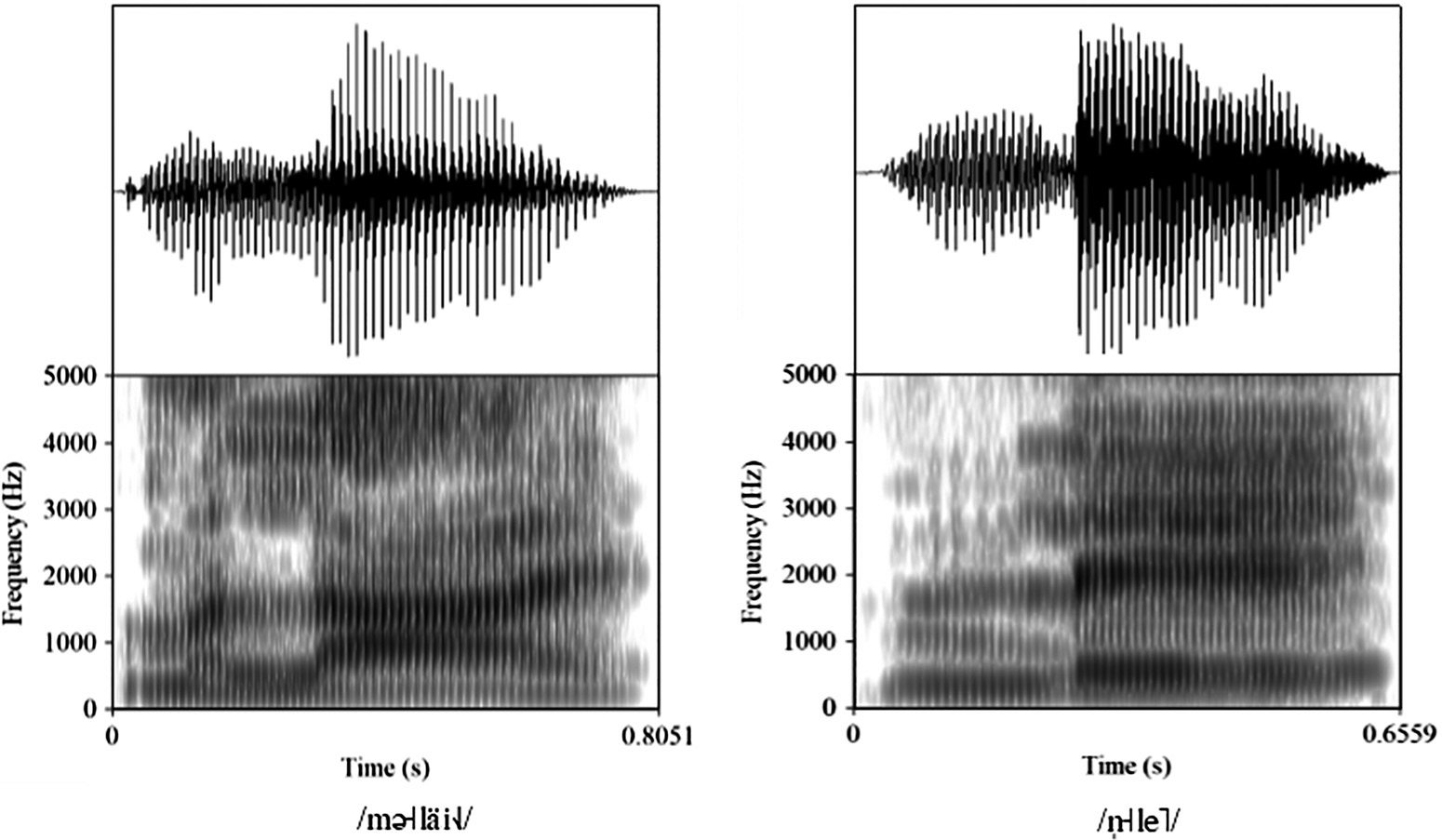
Figure 10 Khongso sesquisyllablic words.
Table 5 Major syllable.
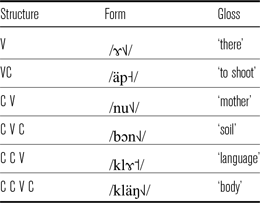
Major syllable structure
In the narratives in my Khongso corpus, described in the introduction, CV and CVC are by far the most common major syllable types, but V, VC, CCV, and CCVC are possible. The major syllable is diagrammed in Table 4 as (CI)(C2)V(CF) and examples are presented in Table 5. In major syllables, all consonant phonemes can occur in the initial position of the onset (CI), but only /j w r l/ can occur in the second position of complex onsets (C2). In the coda, only unaspirated, voiceless stops /p t k ʔ/, nasals /m n Ŋ/, and the voiced alveolar trill /r/ may occur.
Onset of major syllables
The initial C is the least limited element of the syllable. Any phonemic consonant may occur in this position. Consonant clusters are only found in the onset. Consonant clusters, illustrated in (4) and (5), are restricted to aspirated and unaspirated voiceless stops followed by liquids and semivowels. The full list of possible consonant clusters in onset position is presented in Table 6.
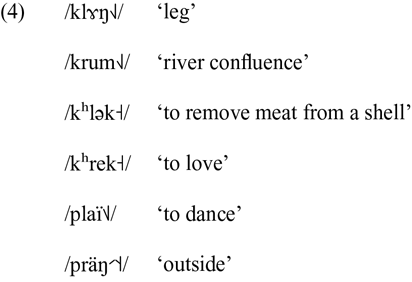

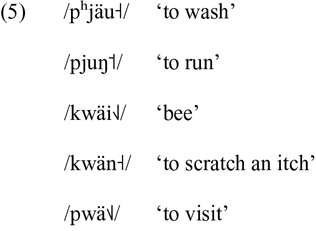
Table 6 Attested consonant clusters occurring in major syllables.
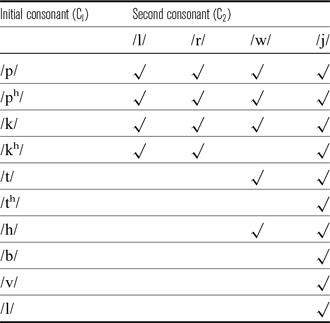
Nucleus and coda of major syllables
The nucleus may only be a single vowel or a diphthong. Consonant codas do not occur after diphthongs, except in loan words, such as /tʃäunว/ ‘school’. With a single vowel nucleus, codas may occur. In the coda, all stops /p/, /t/, /k/, and /ʔ/ are unreleased. Nasals /m/, /n/, /Ŋ/ and voiced alveolar trills /r/ may also occur in the coda as illustrated in (6).
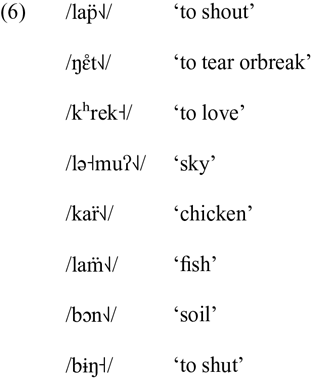
With few exceptions, codas do not occur in non-final syllables in polysyllabic words. In one exception, /l/ appears in the coda of the second syllable, as shown in (7).
![]()
In (8), the syllable-final /s/ appears because it is a loan word.
![]()
Minor syllable
The most common onsets in minor syllables are /k/, /l/, and /m/ (Table 7). Consonants /n/, /Ŋ/, /r/, /s/, /t/, and /v/ are attested in minor syllables with less frequency. Minor syllables cannot constitute words by themselves.
Table 7 Common minor syllables.

In minor syllables, nasals /m/, /n/, and /Ŋ/ occur with a following /ə/ (/Nə/). However, syllabic nasals /m̩/, /n̩/, and /Ŋ̩/ can also occur. Typically, when a syllabic nasal occurs, it occurs in the same place of articulation as the major syllable onset, suggesting a homorganic syllabic nasal, as shown in (9).
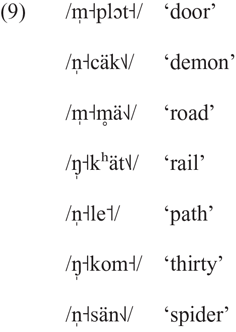
However, syllabic nasals do occur before major syllable onsets that do not share the same place of articulation, and /Nə/ minor syllables do occur before major syllable onsets that share the same place of articulation.
Conclusion
Overall, the Khongso consonant inventory consists of voiced and voiceless sets of plosives, nasals, and trills, as well as four fricatives, two approximants, and two laterals. The vowel system consists of ten monophthongs that occur in open and closed syllables and seven diphthongs that occur only in open syllables. The tone system consists of five phonological tones. Khongso word structures are mainly monosyllabic, but multisyllabic words can occur. Disyllabic words are mainly sesquisyllabic, being comprised of a reduced minor syllable followed by a full major syllable. Trisyllabic words are rare and contain two reduced syllables followed by a full major syllable. The structure of major syllables is diagrammed as (CI)(C2)V(CF) and minor syllables are CI![]() and N̩.
and N̩.
Transcription of recorded passage: ‘The North Wind and the Sun’
Prior to 2006 Khongso had never been written. The author, Wright, worked with the Khongso people in 2006 to develop the orthography below, which is the only known orthography for the language in use today. A similar orthography was simultaneously developed together with the Anu. Literacy committees were formed in each group to make literacy and orthographic decisions. The final orthographic decisions were made by each community. The Khongso people decided not to mark tone in the orthography. The primary Khongso committee members were a part of the Christian community, but efforts were made to include all members of the community in the literacy process. The story was translated from English and then audio recorded in Khongso by a Khongso research assistant in Yangon. It was translated by Wright and the research assistant. Wright transcribed the recording using a broad phonemic transcription.
Orthographic version
Takthang hai Tim hak Rasa
Vanki up khuk khü imi jua kai pin mikha takthang hai tim hak rasa cü mimi hra ky kük by peimih ka-eikja peh. Mi kaipin mih imi khlxt hmat hai vanki mih par khüm py ri mih imi cü hra kykük mih peinü hmai hüm peimih ra-ui kadxja peh. Hna kacü takthang hai tim cü kaipin mih imi hüm hmat mah hra vei mirük hutjok peh. Mitawk kapü mi imi cü hmat hai vanki hly kapaurat, kapaurat vit peikhü, kung kacü takthang hai tim cü kanawn vit ky peh. Hna kacü kaipin mih imi kham rasa cü raujok mikha kaipin mih imi cü hmat hai vanki hüm khlxt pai vit kypeh. Hnakha kacü takthang hai tim cü mija long rasa ni hra kykük peikhü txr peh.
Phonemic version
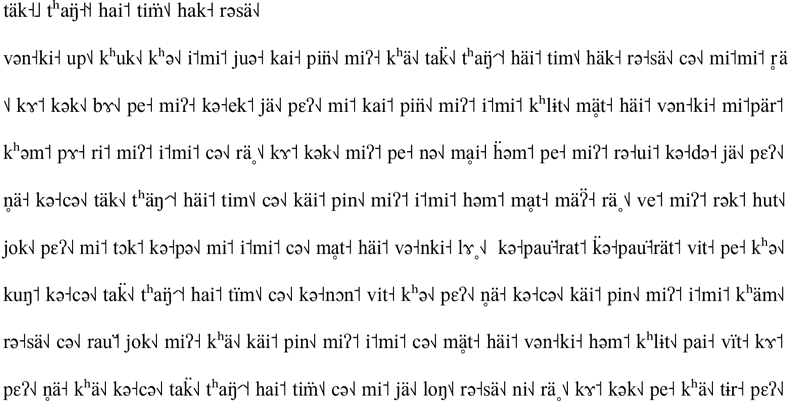
Original English version
The North Wind and the Sun
The North Wind and the Sun were disputing which was the stronger, when a traveler came along wrapped in a warm cloak. They agreed that the one who first succeeded in making the traveler take his cloak off should be considered stronger than the other. Then the North Wind blew as hard as he could, but the more he blew the more closely did the traveler fold his cloak around him; and at last the North Wind gave up the attempt. Then the Sun shone out warmly, and immediately the traveler took off his cloak. And so the North Wind had to confess that the Sun was the stronger of the two.
Interlinearized version
This version contains the phonemic transcription, the interlinear gloss, and the English translation of the text.
Abbreviations
1, 3 first, third person evid evidential pl plural
bkgr background irr irrealis poss possessive
clf classifier lnk linker prt particle
cop copula loc locative subj subject
decl declarative obj object sup superlative
det determiner perf perfect temp temporal
du dual pfv perfective top topic
















Acknowledgements
I am grateful for the careful and constructive collaborative feedback from the editors Amalia Arvaniti, Adrian Simpson, and Marija Tabain and the copy-editor Ewa Jaworska. I am also grateful for the assistance of André Radtke throughout the process of improving the audio recordings. I am also grateful for the constructive feedback of two anonymous reviewers. Finally, I thank Saya Kyaw Kyaw for his knowledge and voice throughout the process of documentation, analysis, and orthography creation.
Supplementary material
To view supplementary material for this article (including audio files to accompany the language examples), please visit https://doi.org/10.1017/S0025100320000286.



